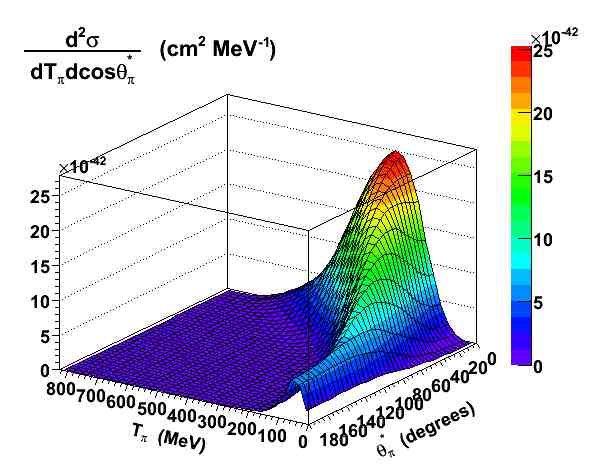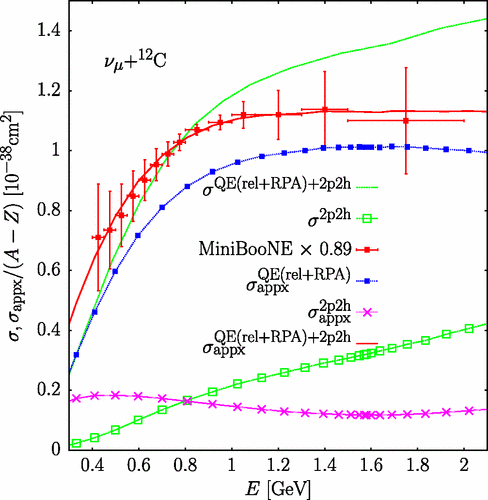
The experimental confirmation of neutrino oscillations -which was
rewarded with a Nobel Prize in 2015 !- sparked off an enormous
experimental and theoretical interest in the oscillation properties of
these elusive particles. Worldwide, several collaborations are
working on extending our knowledge about neutrino masses and mixing
angles.
Oscillation experiments are essentially about counting : the
difference in number of neutrinos of a certain flavor between a
detector near the neutrino source and a far detector, several hundred
kilometers away, allows one to collect information about the
neutrinos' oscillation characteristics.
One of the main
neutrino-detection mechanisms that is used in these experiments is the
scattering of neutrinos off atomic nuclei. Experimentally, these
neutrino interactions suffer from a number of complications in
comparison with the related electromagnetic scattering reactions :
neutrino cross sections are very small, making it challenging to
collect sufficient data ; the neutrinos contributing to the signal in
the detector have widely varying energies and in a specific event the
precise incoming energy is unknown ; and in neutral-current reactions
the outgoing lepton is again a neutrino that cannot be detected,
complicating the reconstruction of the energy balance at the
weak-interaction vertex. These limitations moreover result in the
fact that the incoming flux tends to be only poorly known, hampering
the normalization of reaction rates.
The analysis of
neutrino-oscillation experiments hence strongly depends on a good
understanding of the underlying reaction mechanisms.
The neutrino group at Ghent University is part of the worldwide NuSTEC
(Neutrino Scattering Theory-Experiment Collaboration) network, and is
involved in vivid collaborations with other research groups working in neutrino-nucleus physics.
In the context of the thesis work in this group,
there is ample opportunity for research stays at foreign institutions
(e.g. IRFU Saclay, University of Madrid, University of Geneva, Wroclaw University)

In coherent processes, low-energy neutrinos are scattered off the nucleus as a whole, without resolving the individual nucleons. The lack of detectable reaction products hampers experimental studies of the process as these have to rely on measurements of the (small) recoil energies of the target nuclei. On the other hand, the coherent reaction mechanism has the advantage that the cross section is relatively large, and dominates the 'standard' inelastic neutrino-nucleus scattering processes for incoming energies up to a few tens of MeVs. This makes the coherent process important for astrophysical neutrinos where the large cross sections make it an important instrument for the transfer of energy from the neutrino to the surrounding material. In particular, this is the case for supernova neutrinos, both for their interactions within the collapsing and exploding star core as for their detection on earth. The difficulties met by experiments measuring these coherent cross sections, make theoretical simulations all the more important. The theoretical description of the target nucleus is non-trivial. Each nucleus is constructed of protons and neutrons which are constantly interacting with each other through nuclear forces. This thesis project has following goals:

A central issue in current neutrino experiments is the lack of a monochromatic neutrino beam.
This stands in stark contrast with experiments that use charged leptons as projectiles, where
the incoming energy is well-known.
The incoming neutrino energy has
to be reconstructed from experimentally measurable variables which do not fully specify the kinematics of the process.
This means that the interpretation of reconstructed variables strongly depends on the understanding of the interaction of the neutrino with the nucleus.
The reconstructed variables are usually interpreted by using Monte Carlo generators,
which typically employ simplified interaction models.
Using detailed microscopic models we are in the position to interpret the model-dependent relation between real and reconstructed variables.
The effect on measurements of neutrino oscillation parameters can be large.
Therefore this subject attracts a lot of interest from within the experimental community.
For example, the unrealistically large charged-current quasi-elastic cross section measured in the MiniBooNE was partially explained by including the effect of multinucleon knock-out processes.
This reaction channel skewed the distribution of reconstructed energies leading to an excess of events for low values of the reconstructed energy.
Using a mean-field approach for the description of the nuclear structure tends to skew the distribution in a similar way,
which might be important in the interpretation of the electron-neutrino excess found at low reconstructed energies.
Who knows how many more of these reconstruction artifacts are present in current data?

A thorough understanding of the interaction between neutrinos and nuclei is essential in the interpretation of oscillation experiments. In our research group theoretical models are developed to explain experimental results, but in the scientific process, besides experiment and theory, there's a third aspect: computational simulations. These simulations form a bridge between theoretical models and experimental results. GENIE (Generates Events for Neutrino Interaction Experiments) and NuWro are two state-of-the-art neutrino event generators that are freely available. These are used by several experimental collaborations such as MiniBooNE, MINERvA and T2K to assess the feasibility of the proposed experiments, to design the detectors and to determine the efficiency of these detectors.
The goal of this thesis subject is to start a comparative study between these Monte Carlo simulations and the models developed in our own group. Afterwards attention will be given to experiments such as ArgoNeuT and MicroBooNe. Contrary to experiments from the previous generation these ones also measure, besides the muon, the knocked-out nucleons. Are the Monte Carlo simulations also suitable to predict these semi-exclusive measurements? Experimental results aren't yet available, but our own models are suitable for a comparison.
This thesis subject offers the opportunity to spend a research stay in the neutrino research group of Wroclaw University, originators of the NuWro generator.